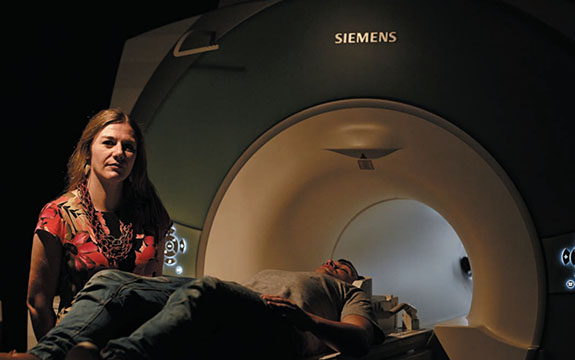Finding a voice of reason amongst schizophrenia

In Summary
- This article featured in Swinburne’s 2017 ‘Research Impact’ magazine, produced in association with Nature Publishing Group.
Research has shown the voices heard by people with schizophrenia may be thoughts perceived as sound. A new Swinburne study is trying to track down exactly where in the brain the signal goes awry.
As many as 80 per cent of schizophrenia sufferers hear voices; sometimes sporadically, sometimes chronically. Auditory hallucinations also affect people with bipolar disorder, depression, borderline personality disorder, and even people with no other manifestations of mental illness.
The causes of auditory hallucinations have occupied Professor Susan Rossell for more than two decades. A cognitive neuropsychologist at Swinburne University of Technology, she’s using powerful new imaging technology to study why some people hear voices and what can be done to help them manage it.
One insight from Rossell’s work is that voice-hearing appears to be an abnormal experience of a very normal human phenomenon — internal self-talk.
“We all have internal dialogue but we can choose to listen to our thoughts or not to listen to our thoughts,” Rossell says.
Her previous work has shown that this internal dialogue activates the same regions of the brain — the language processing centres — as when someone real is talking to us.
Most people are able to tune out this internal voice, along with all the other extraneous auditory stimuli we are constantly exposed to, such as traffic noise, birds, and other conversations. But, this ‘attention inhibition’ switch is what Rossell thinks might be malfunctioning in conditions such as schizophrenia.
“We think people who hear voices are not able to correctly filter out the noise in the world around them and included in that noise is their own internal dialogue.”
This discovery was profound for Rossell and her patients. “When we worked out that hearing voices was just a normal linguistic experience, it was incredibly relieving for the sufferers because we were able to tell our patients that this is part of normal language,” she says.
“They really like it, because they’ve been told for years that their brain is wrong.”
This discovery raised the question of why people with schizophrenia and other conditions aren’t able to tune out the voices.
To explore this, Rossell and her colleagues are combining conventional magnetic resonance imaging (MRI) and magnetoencephalography (MEG), a new imaging technique. MEG shows the magnetic patterns produced by the brain’s electrical activity, in very fine detail and in real-time, while the MRI will enable researchers to look at the brain structures activated when people hear voices.
Patients sit in the MEG scanner and are given a button to push whenever they hear a voice.
“What we’re doing for the first time is looking at the 20 seconds before the voice-hearing experience to explore what brain mechanisms are involved in the trigger and causing the voice,” Rossell says.
“This experiment is trying to study these attention inhibition networks just before the voice experience to see if there is an area of the brain that is activated incorrectly, because nobody’s been able to look at that before.”
Read the full story as part of Swinburne’s Research Impact magazine.

